GARDEN FEATURES
In order to break the monotony and to enhance the beauty, any garden should contain components of varying nature. Following are certain important features:
Avenue
An avenue is the row of trees grown on both sides of roads. Shade and beauty are the sole criteria to be considered while selecting avenue trees. The trees should also be selected according to the length and breadth of the road.
AVENUE PLANTING
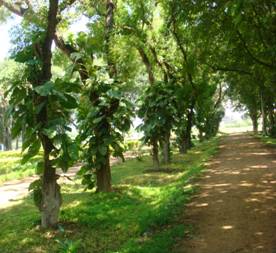 
Topiary
It is the art of developing the plant or training the plant into different forms or shapes like animals, birds, arches, etc. The plant should be amenable for repeated pruning and also flexible with more vegetative growth.
(eg) Hills – Cupressus macrocarpa, Pinus patula
Plains – Casuarina sp., Caesalphinia coriari, Bougainvillea sp., Jaminum sp.
TOPIARY
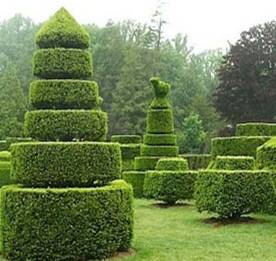 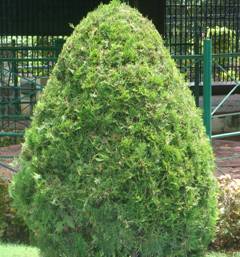
Lawn
It enhances the beauty of a garden whether it is small or large. It finds the most important component of a garden giving a view of a green carpet.
LAWN WITH SHADE GRASS

Trophy
It is the arrangement of colourful potted plants in different tiers around a central object which may be a tree trunk, lamp post or a pillar.
TROPHY

Carpet beds
The art of growing ground cover plants closely and trimming them to a design or alphabetical letters is called a carpet bed. Colourful foliage as edge plants is found to be more suitable for this purpose. (eg.) Alternenthera.
Shrubs and Shrubbery
Growing of shrubs in a group is called shrubbery. It is of two types (i) Pure shrubbery (ii) Mixed shrubbery. Pure shrubbery refers to planting of entire selected area with a single species and the opposite holds good for mixed shrubbery.
Shrubs for showy or attractive flowers (e.g.) Hibiscus, Ixora, Mussanda, Night queen, Euphorbia etc., Shrubs for fragrance (e.g.) Jasmine, Rose, Nandiayavattai (Tabernaemontana), Pavalamalli (Nyctanthes) etc. Shrubs for foliage (e.g.) Crotons, Polycias, Eranthemum, graptophyllum, etc.
Arboretum
Growing of different species of trees in one place is called ‘Arboretum'. The trees form the main frame work of the garden. Group of trees in one place will help to give depth to the garden. Trees are very fascinating because of their graceful appearance and the abundance of bloom. They are grown for their economic importance or aesthetic value or both.
Flower beds and Borders
Annuals and herbaceous perennials are grown in flower beds to provide massing effect of different colours. Borders are continuous beds of more length than width containing plants of one kind only.
Flower bed
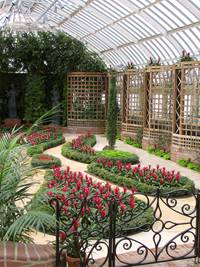
Ground cover
When a dicot plant is of straggling nature is used to cover the ground surface is called ground cover (eg.) Wedalia, Verbena, Ipomea, Acalypha, Portulaca.
Climbers and creepers
A group of ornamental plants used to grow over walls, trellis, arches, pergolas, arbours, pillars, bowers, etc. These are grouped as light or heavy according to the amount of wood it produces.
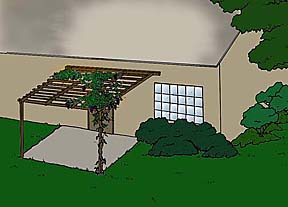
Annual climbers (e.g.) Clitoria ternatea, sweet pea,morning glory (Ipomoea rubrocaerulea)
Clitoria ternatea
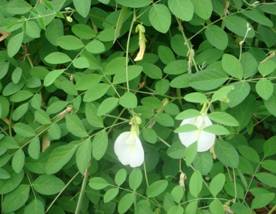 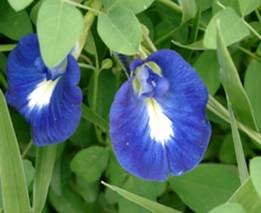
Climbers for screening (e.g.) Antigonon leptopus, Passiflora, Porana Ipomoea, Clerodendron splendens, Thunbergia etc.
Clerodendron splendens
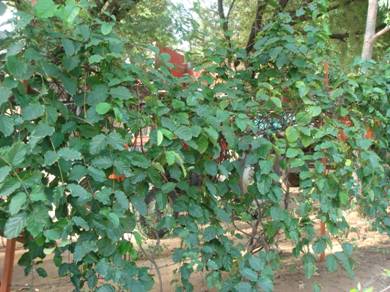
Climbers for low walls or trellis for this purpose only light climbers are selected. (e.g.) Lonicera japonica, Solanum seaforthianum, Tristellatia australis, Tecoma jasminoides, Jacquemontia violacea.
Climbers for pergola usually heavy climbers are grown. (e.g.) Quisqualis indica, Petrea volubilis, Adenocalymma allicea, Allamanda cathartica, etc.
Quisqualis indica
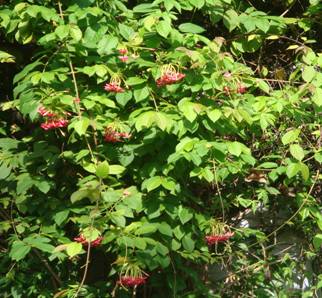
Allamanda cathartica

Climbers for porches (e.g.) Pyrostegia venusta, Petrea volubilis, Clerodendron splendens, Bougainvillea, Jasminum sp. etc.
Flowering climbers in partial shade (e.g.) Passiflora, Aristolochia, Quisqualis indica, Clerodendron splendens, Jacquemontia violaceae. Foliage climbers (e.g.) Scindapsus aureus, Philodendron sp., Monstera deliciosa.
Scindapsus aureus Philodendron
 
Climbers for pot culture (e.g.) Tristellatia asutralis, Adenocalymma allicea, Clitoira ternatea, Bignonia purpurea etc.
Flowering annuals
Antirrhinum, stocks, dwarf sweet pea, pansy, dahlia, chrysanthemum, marigold, sweet alyssum, phlox, pinks (Dianthus) and verbena.
Dahlia
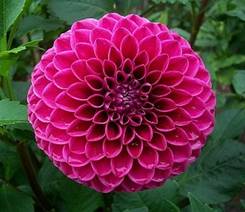
Herbaceous perennials
Pelargoniums, Michaelmas daisy, Cenna, Mirabilis jalapa, Portulaca, Solidago Canadensis, Vinca rosea, and Perennial verbena.
Portulaca
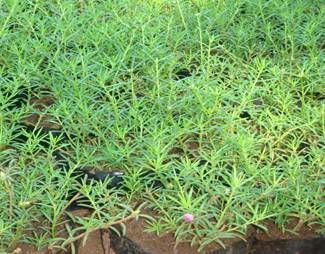
Trees
One or two drawf trees such Plumeria sp. Callistemon lanceolatus and Gliricida maculata can be grown as specimen plants. Some large to medium trees such as Araucaria cookii, Mimusops elengi, Brassaia actinophylla, etc., can also be grown till they are young.
Callistemon lanceolatus

Bulbs
A variety of bulbous plants of annual or perennial nature can be grown.
Water plants
Water lillies and other water plants can be grown in the lily pool, if any or in cement tubs.
Water lily
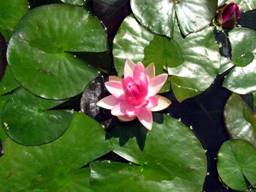
Hedges
With the help of plants, live hedges can be formed and used as a fence or a green wall. It serves to screen a particular site or building or hiding of unwanted places. They help to partition the garden into several parts. It provides a natural background to a garden, like a frame to a picture. The characteristics of a good hedge are that it should be thick and dense; it should have foliage from the bottom to top; it should be trim and neat; if it is a flowering hedge its bloom should not clash with the general colour scheme.
Some of the most common foliage hedges are Acalypha with its copper-red leaves, it is suitable for a medium hedge; Clerodendron inerme an evergreen drought-resistant plant used frequently by the roadside, is not eaten by cattle or goats, and is suitable for a low to medium hedge; Duranta is also an evergreen drought-resistant fast-growing plant with very neat habit and bright green foliage, suitable as a medium hedge; Dodonea viscose with its evergreen narrow shining leaves suitable as a medium hedge; Pithecalobium dulci (Inga dulce) with its thorough stems and small feathery leaves making an impregnable medium to tall hedge; Lawsonia alba (Maruthani) with its pretty small bright green leaves is suitable as a low to medium hedge; Murraya exotica with its small dark green leaves is suitable for any size of hedge. There is a large variety of flowering plants which can be used as hedges. The most prominent of these is the Bougainvillea. A variety like ‘Thimma’ or ‘Dr. Rao’, or ‘Louise Wathena variegated’ gives pretty blooms as well as beautiful variegated leaves.
Acalypha

The other common flowering hedges are Beloperone amhersita with its perpetual rust-colored bracts overlapping small white flower, Buddleia aisatica with gray green foliage and conical fragrant clusters of off-white flowers; Hamelia patens with red-veined leaves like Fuchsia and attractive orange-colored flowers in the rainy season; Hibiscus with its trumpet like bright flowers of orange, pink, white, red, purple, etc. with dark green bright foliage; Jatropha with its star-like rose-crimson flowers; Lantana with its compact dark-green foliage and round cluster of flowers; Lonicera japonica (honeysuckle) with beautiful fragrant white flowers and small dark-green leaves; Plumbago with pearl blue flowers; Pomegranate with tiny leaves and bright scarlet flowers; Tabernaemontana coronaria with star-like pure-white flowers, decorating dark-green shining leaves; and Tecoma stans with bright yellow trumpet-like flowers.
Tecoma stans
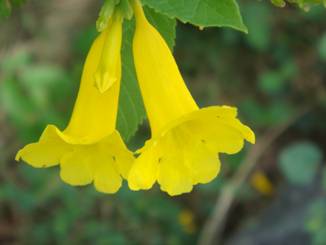
Edges
These are perennial herbs often used as a short border for lawn or ground cover or dividing beds from roads, walks or paths. These herbs often stand frequent trimming. They consist of live material like the dwarf plants or inert material like bricks, stone slabs or corrugated iron sheets. The common evergreen edges used for edging are Eupatorium and Alternanthera. Justicea is capable of standing rainfed or drought conditions. Pilea, dwarf marigold and dwarf Coleus are also used as edges in rockeries.
Dwarf marigold
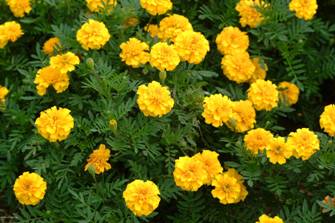
Suitable plants as informal edgings
Achillea tomentosa and A. tonbellata
Alyssum saxatile
Bellis perennis varieties
Campanula, all dwarf species
Dianthus deltoids, D. squarrosus, etc.
Geranium farreri and G. sanguineum
Gypsophila repens
Hypericum olympicum
Iberis sampervirens
Linum salsoloides
Phlox subulata varieties
Polyanthus varieties
Priumula pulgaris varieties
Conservatory or summer house
It is made of wood and iron to the size of the glass house. It can be located in a cool shady place. Shade loving plants are mainly grown in pots which are highly priced for the ornamental foliage. It is also called as green house and glass house. It helps to create a special environ with cool, airy, humid and marshy soil for shade loving, moisture loving and water loving plants. The root of such structure is made of wooden reapers, angle irons and concrete poles and covered with mesh or natural creepers. A tank or water trough is constructed at the center to increase humidity and few benches are provided for the display of plants. Such structures can be erected under a partial shade preferably.
Sunken garden
It is formed by taking the advantage of a natural depression. The depression is made into different tiers over which ground covers, edges, flower beds and small herbs may be grown. At the center of depression, a pond or pool is formed to grow water plants.
Rock garden
A rock garden is the arrangement of rocks with plants grown in the crevices. Its bold ruggedness is a pleasant contrast to the softness of the flowers. The stones help the plants in retaining their moisture and keeping their roots cool. In plains, on the sunny side some of the cacti & succulents; Lantana, Setcreasea, Verbena, etc can be grown successfully. Ferns and some indoor plants also look natural on the rockery slopes in shade.
Lantana camera

Water garden
It may have a water course, a water pond and a water fountain or any one or more of these features, harbouring water loving and marsh plants. Water gardens, no matter, how tiny, are extremely effective in beautifying the landscape. Water lilies (Nymphaea) are the most popular water plants.Another aspect to be considered is the depth of water. The large tank is around 3-5 m deep at the deepest point. A reflecting garden pool is preferably shallow with a depth of 25-30 cm. If hydrophytic plants are to be grown, varying depths have to be provided in the same pond, which may range from 15 to 90 cm, the deepest portion allotted to lotus and water lilies. In shallow pockets and galleries, swamp plants such as Typha and Cyperus are accommodated. Salvinia, Pista and other floating plants may be conveniently added to this grouping. Provision is necessary to prevent rain water and through it silt entering into the pool. A slightly raised rim to a height of 10 cm will be helpful in this regard. Provision to drain the pool by providing an outlet at its floor level will help to clean it, as often as is necessary.
Water garden

Two level garden / Formal garden
This is also called as an "Italian style" or 'scroll' garden. It is symmetric with two tiers, the down tier is grown with flower beds, edges, etc. and a small pond at the centre. The upper tier is decorated with flowering shrubs, hedges, etc.
Japanese garden
Japanese garden is mainly divided into three types namely
- Mountain garden
- Island garden
- Tea garden
The paths and roads in these gardens are narrow and bushy plants are grown along the path to provide concealment. Islands are interconnected by bridges made up of stones or bamboo or stems of palms. The mountains are the source of water located at one side of the garden. River stones, water plants, bamboo, dwarf trees, stone lanterns are the components in these gardens. Bamboos, cycads are the commonly found ornamental plants in this garden.
Garden adornments
There are several garden adornments and accessories such as fountains, statues, garden seats, ornamental posts and pillars, arches and pergolas, trellises, hanging baskets, tubs, vases and urns with plants which make the garden more enjoyable. Playing of a fountain is an interesting feature in a garden and the water in the cistern should be kept clean. Garden seats made up of stones, concrete or metal are placed under the tree. Handsome tubs, vessels and urns are utilized to display plants in conspicuous places. Arbours, arches, pergolas and trellises serve as support to several beautiful plants and to dispel monotony in garden. Arbours are usually open in all sides. Very often a long wall or the end of a pergola leads to an arbour. Arches are generally erected over walks, usually at the entrance and are usually two meters in height. Pergolas are series of arches connected over a walk.
Source
1. http://www.buy-garden-plants-online.co.uk/images/Topiary.jpg
2. http://www.dahlia.org/guide/welcome.jpg
3. www.mooseyscountrygarden.com/hampton-court-fl...
4. http://www.houma.com/Portals/0/images2/marigold.jpg
5. http://upload.wikimedia.org/wikipedia/commons/7/7e/Lantana_camaraflower.JPG
6. http://aggie-horticulture.tamu.edu/extension/homelandscape/construct/construct.html |
























